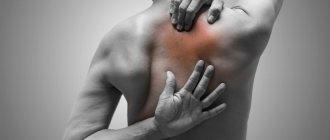70% of adults have neck pain of varying frequency. At the same time, pain can not only be of a different nature, but also caused by a variety of diseases. Therefore, they are generally not observed in isolation, but are accompanied by other symptoms that help to correctly diagnose and select the optimal treatment tactics.
Types of neck pain
Neck pain can be short-term and limited to minor discomfort, or very acute, significantly interfering with everyday life. More often, people complain that they suddenly feel a shooting sensation, followed by persistent pain. It can be aching, tingling, pulsating, squeezing and of a different nature.
Neck pain is also called cervicalgia.
Discomfort usually increases during movements, for example, when turning or tilting the head, while maintaining a static, especially uncomfortable position for a long time, in particular when working at a computer for a long time. In this regard, a person is forced, often even unconsciously, to turn his whole body in order to spare his neck as much as possible.
So, it is clear that neck pain can be very different. Therefore, they are divided not only into acute (lasting less than 10 days) and chronic, but also into:
- vertebrogenic – occurring against the background of pathological changes in the cervical spine, including damage to the intervertebral discs, compression of the spinal roots and spinal cord;
- nonvertebrogenic - resulting from all other causes, including infectious diseases, inflammatory processes in the muscles, diseases of the thyroid gland, lymph nodes, etc.
Vertebrogenic pain is characterized by irradiation to the occipital region, shoulders, arms, up to the hands and fingers. Often, numbness, impaired sensitivity and mobility are observed, which indicates the development of neurological disorders, i.e., infringement by a particular anatomical structure of the nerve roots or spinal cord. Also in such situations, dizziness, attacks of loss of consciousness and headaches may occur, which indicates compression of the vertebral arteries, for example, by an intervertebral hernia.
It is necessary to make an urgent appointment with a doctor if the neck pain is acute or accompanied by dizziness, a feeling of numbness in the back of the head, or tinnitus.
Causes of neck pain
Sometimes it is difficult for patients to independently differentiate a sore throat from a pain in the neck, since it can be so diffuse that the sensations are blurred and it seems that the whole neck hurts. If this is accompanied by a feeling of soreness or scratching in the throat, an increase in body temperature, then this may indicate laryngitis, ARVI, sore throat, pharyngitis and other colds. Also, such symptoms are typical for:
- gastroesophageal reflux;
- Itsenko-Cushing syndrome;
- foreign bodies entering the throat, for example, fish bones;
- hypovitaminosis;
- formation of benign and malignant tumors in the throat.
But still, in most cases, people can differentiate problems with the throat from true pain in the neck, which can be observed both on the anterolateral surfaces, and behind and in front.
Localization of pain is an important diagnostic sign, which allows you to determine the source of pain at the examination stage, and subsequently thoroughly study the changes that have occurred using instrumental diagnostic methods.
Pain in the front of the neck: causes
The occurrence of unpleasant or even painful sensations directly in the area under the chin or diffuse pain along the entire front of the neck may indicate:
- thyroid diseases;
- inflammatory processes in muscles affecting ligaments and nerves;
- formation of cysts and abscesses;
- damage to the lymph nodes;
- angina pectoris.
That is, the list of possible causes is quite extensive and it is impossible to independently determine what exactly caused neck pain. In such situations, it is worth contacting a therapist for an examination. If necessary, the doctor will refer the patient to a specialist of the required profile.
Also, pain in the front of the neck can be accompanied by vertebral artery syndrome and radicular syndrome. In both cases, the cause is the pinching of blood vessels or nerves by a deformed intervertebral disc, edematous tissue, a displaced cervical vertebral body, or other structure. Our clinic has developed an integrated approach to solving this problem - experienced chiropractors, neurologists, rehabilitation specialists, endocrinologists will conduct an examination and prescribe the necessary treatment.
Pain in the back of the neck: causes
Due to the peculiarities of the modern lifestyle, people are very often bothered by pain in the back of the neck. Working at a computer, constant use of gadgets, low levels of physical activity and bad habits, all this causes pathological changes in the structure of the spine, which manifest themselves as neck pain. Therefore, if aching, nagging, sharp pain or shooting in the back of the neck occurs, first of all, consultation with a chiropractor or vertebrologist is required, since in the vast majority of cases this indicates diseases of the cervical spine, namely:
- osteochondrosis is a widespread disease accompanied by degenerative changes in the intervertebral discs, a decrease in their height and a decrease in strength;
- protrusion – a complication of osteochondrosis, in which the intervertebral disc protrudes (usually into the spinal canal, where the spinal cord and nerve roots pass), which creates a risk of pinching nerves and vertebral arteries;
- intervertebral hernia is a consequence of untreated protrusion, in which the internal contents of the intervertebral disc penetrate into the spinal canal, gradually increase and can seriously compress the nerves and spinal cord, and at the last stage of development, separate and “travel” along the spinal canal, causing serious and sometimes irreversible complications including paralysis;
- spondylosis is a complication of osteochondrosis, in which bone protrusions called osteophytes grow along the edges of the vertebral bodies, and the intervertebral discs become critically flattened, which over time leads to the fusion of adjacent vertebrae with each other and limitation of neck mobility;
- myofascial syndrome - a disease in which individual muscles spasm, which leads to attacks of acute pain during physical activity or when pressing on certain points in the neck area;
- vertebral compression fractures - most often occur in older people due to osteoporosis or are the result of a whiplash injury, for example in an accident, and pose a serious threat to human life and health;
- Ankylosing spondylitis is a systemic disease that affects almost all joints of the body and causes severe limitations in mobility due to the fusion of individual vertebrae, forming strong and immobile conglomerates.
Much less commonly, pain in the back of the neck is caused by spinal tuberculosis, osteomyelitis or Reiter's syndrome.
Side neck pain: causes
Most often, the pain in the lateral surfaces of the neck is burning or throbbing, and it can also be tingling in nature. They tend to radiate to the shoulder and ear, sometimes accompanied by the formation of secondary torticollis, as a result of which the head tilts to the affected side. This is typical for:
- pathologies of blood vessels, including atherosclerosis;
- muscle spasms, which can be provoked by heavy strain on the neck, sudden movement or hypothermia;
- formation of malignant tumors in the thyroid gland, pharynx and larynx.
Symptoms
The pain is most often sharp, but can also be dull or with a burning, tingling or electrical sensation. The pain can lead to neck or shoulder stiffness and decreased range of motion. In addition, there may also be a headache. The peculiarity of the symptoms is important for the doctor, as it allows you to find out the cause of the pain syndrome.
Weakness may be associated with severe pain in the muscles or bones when moving. In addition, damage can also affect nerves and therefore it is necessary to differentiate true weakness (muscular or nerve) from reduced weakness associated with pain or inflammation.
Numbness. If there is compression (bruise, injury) of the nerves, sensitivity may be impaired. In addition to numbness, there may be a tingling or sinking sensation.
Cold weather. Cold arms or hands may indicate possible damage to veins or arteries. This symptom usually indicates insufficient blood circulation in the limb.
Color change. Blue or pale discoloration of the arm or shoulder may also be a sign of damage to the veins or arteries. Redness may be a sign of infection or inflammation.
Swelling. Swelling can be either generalized throughout the arm or local in the area of problematic structures (for example, a fracture zone or an inflamed bursa). Muscle spasms or tightness can simulate swelling. Dislocation or deformation can also cause swelling.
Deformation can occur due to a fracture or dislocation. Tendon ruptures can cause abnormal alignment of bone structures.
If you have symptoms such as increasing pain, weakness, coldness of the limb, deformity, fever, or symptoms such as dizziness, difficulty breathing or severe numbness or weakness, you should immediately seek medical help.
Diagnosis of the causes of neck pain
Since in the vast majority of cases, neck pain is caused by the development of pathologies of the cervical spine, if they appear, you should contact a chiropractor, vertebrologist or neurologist. Based on the complaints, examination data and neurological tests, the doctor will be able to determine whether the discomfort in the neck is really due to disorders in the spine or is caused by other diseases.
Nevertheless, it is precisely deviations from the norm in the condition of the spine that, in fact, are one of the reasons for the development of concomitant diseases of the internal organs. After all, changes in the position of the vertebrae, a decrease in the height of the intervertebral discs and other, even minor changes, lead to disruption of the transmission of nerve impulses from the spinal cord through the nerve roots along the nerves to the internal organs.
Since the spinal cord is distinguished by segmental innervation, i.e. each section is responsible for the correct functioning of a specific organ, if disorders occur in the cervical spine, it is the innervation of the ENT organs, vocal cords, thyroid and parathyroid glands, as well as neck muscles that may suffer , shoulders and forearms. Therefore, initially their work is disrupted, and over time, organic changes occur, that is, one or another disease develops, which can provoke pain of varying intensity and nature in the neck.
Therefore, diseases of internal organs are extremely rarely diagnosed and changes in the spine are not detected, and therefore consultation with a chiropractor is mandatory. But if the patient has signs of diseases of the thyroid gland, heart, ENT organs or others, he is additionally advised to obtain consultation from specialized specialists (endocrinologist, cardiologist, otolaryngologist, etc.).
Thus, diagnosing the causes of neck pain is always complex. This may include:
- general and biochemical blood test;
- determination of the level of thyroid hormones in the blood;
- Ultrasound with Dopplerography of the vessels of the neck, thyroid gland, salivary glands;
- X-ray of the cervical spine;
- electroneuromyography;
- CT;
- MRI.
For the purpose of diagnosing pathologies of the spine, MRI, i.e. magnetic resonance imaging, has the greatest information content. The method allows you to study the condition of the intervertebral discs down to the smallest detail, assess the quality of blood flow in the vertebral arteries, and detect signs of compression of the spinal cord or its roots. With its help, diseases are diagnosed at the earliest stages of development, which ensures the earliest possible start of treatment and its high effectiveness.
In our clinic, you can also learn in more detail about the composition of your body and the state of the vascular system, which is involved in the blood supply to internal organs, skeletal muscles, and the brain. Our experienced doctors will explain the data obtained to you in detail. Bioimpendansometry calculates the ratio of fat, muscle, bone and skeletal mass, total fluid in the body, and basal metabolic rate. The intensity of recommended physical activity depends on the state of muscle mass. Metabolic processes, in turn, affect the body's ability to recover. Based on the indicators of active cell mass, one can judge the level of physical activity and nutritional balance. This simple and quick test helps us identify disturbances in the endocrine system and take the necessary measures. In addition, it is also very important for us to know the condition of blood vessels for the prevention of diseases such as heart attacks, hypertension, heart failure, diabetes and much more. Angioscan allows you to determine such important indicators as the biological age of blood vessels, their stiffness, stress index (which indicates heart rate), and blood oxygen saturation. Such screening will be useful for men and women over 30, athletes, those undergoing long-term and severe treatment, as well as everyone who monitors their health.
In this case, body composition analysis gives us information that adipose tissue predominates in the body, and the bone-muscle component is in relative deficiency. These data will help the rehabilitation doctor competently draw up a physical activity plan, taking into account the individual characteristics of the patient.
Diagnostics
In most cases, the diagnosis can be made based on the history and physical examination. However, instrumental examination methods are prescribed when it is necessary to verify the diagnosis, depending on the nature of the injury, the location of pain and other symptoms.
X-rays are ordered if there is tenderness to palpation of the bones of the spine or shoulder, a history of trauma, the presence of a deformity, or if problems in the lungs or heart are suspected.
ECG - electrocardiography can be prescribed for chest pain, breathing problems and the presence of risk factors for coronary artery disease (high blood pressure, diabetes, high cholesterol, smoking).
tests are prescribed in cases of chest pain, shortening of breathing, and in cases where the doctor suspects the presence of inflammatory diseases.
CT. Computed tomography is prescribed when greater detail of changes in tissues is needed or if there is suspicion of diseases of the chest organs.
MRI. As a rule, MRI is prescribed only in cases where it is necessary to differentiate between various conditions.
Treatment for neck pain
For each patient, treatment tactics are developed strictly individually based on the diagnosis, the severity of pathological changes, the presence of concomitant diseases and other factors. Even patients with the same disorders may be prescribed different treatments, since even age and level of physical development influence it.
Nevertheless, the treatment of diseases that cause neck pain is always complex and includes both symptomatic and etiotropic therapy. In other words, it is aimed at eliminating both the symptoms of the disease and the causes of its occurrence. The main components of therapy are often:
- drug treatment;
- osteopathy;
- manual therapy;
- massage;
- physiotherapy (phonophoresis, carboxytherapy, ozone therapy, RF current pressure therapy);
- individual sessions with a rehabilitation specialist.
When diagnosing pathologies of the cervical spine, it is recommended to make some adjustments to your lifestyle and habits. Thus, office workers, drivers, seamstresses and representatives of other sedentary professions are recommended to stretch as often as possible and avoid long-term forced body positions, especially ones that require tension in the neck muscles.
It is also important to eat properly so that the body receives all the substances it needs. This will not only slow down the progression of pathology, but will also contribute to faster regeneration processes.
In case of severe pain, the chiropractor may recommend that the patient purchase a neck brace or Chance collar. Wearing it will help relieve the load on the cervical spine and avoid making thoughtless sudden movements, which will lead to a gradual fading of the pain syndrome. In our center you can select and purchase a bandage that suits you
Before visiting a doctor, in order to reduce pain, you can wrap your neck with a woolen scarf or take a painkiller tablet no later than 12 hours before your appointment.
Drug therapy
The nature of the prescribed drugs and their quantity can vary within very wide limits, which directly depends on the diagnosis and the presence of concomitant diseases. Therefore, we list only those groups of drugs that are prescribed to the vast majority of patients:
- NSAIDs are nonsteroidal anti-inflammatory drugs that also have analgesic properties (produced in various dosage forms, including tablets, ointments, injection solutions, etc.);
- corticosteroids are drugs with a powerful anti-inflammatory effect, which are used only in cases of severe inflammatory processes that cannot be eliminated by NSAIDs;
- muscle relaxants - medications that eliminate muscle spasms of various origins, which helps reduce the severity of pain;
- chondroprotectors are drugs that promote the restoration of the cartilage tissue that makes up the intervertebral discs, but are effective only in the initial stages of the development of osteochondrosis. To prevent diseases of the musculoskeletal system, we recommend to our patients the most effective drug Mermaids Marine Collagen;
- B vitamins - are used to improve the conductivity of bioelectric impulses from the spinal cord to the corresponding organs and restore their proper functioning;
- Vitamin D is a remedy responsible for the condition of bone tissue, as well as for higher brain functions, such as memory, memory, attention, and speech.
Patients may also be prescribed antibiotics, hormone replacement therapy, antihypertensive drugs, and others.
For particularly severe pain in the neck, blockades are used. The procedures involve the injection of anesthetic solutions with corticosteroids into the area where the nerves pass in the neck, which allows for very quick pain relief. But, in addition to the fact that they are effective only for pain caused by nerve damage, they require a high level of professionalism from medical workers, since when performing a blockade there is a risk of injuring the nerve, causing infection and causing serious complications.
Manual therapy
Manual therapy is one of the most effective ways to combat neck pain and the causes of its occurrence, but only if carried out correctly. It involves a direct impact on the spine and surrounding soft tissues. Do not confuse manual therapy with therapeutic massage, which only works the muscles of the back and neck.
Techniques and methods of manual therapy allow literally after the first session to achieve a significant improvement in well-being, and ultimately complete remission. This is achieved through:
- restoration of the normal axis of the spine by returning the vertebrae to their anatomically correct position;
- increasing the distance between the vertebral bodies and releasing compressed nerves and blood vessels, which helps eliminate signs of radicular syndrome, improve the functioning of internal organs and especially the brain;
- elimination of spasm of neck muscles and functional blocks, which improves mobility and reduces pain;
- improving blood circulation and tissue nutrition.
We do not have general standards of treatment; we apply an individual approach to each patient. You should trust manual therapy only to a highly qualified specialist. Otherwise, the use of inappropriate techniques can only harm the patient, aggravate the problem, or provoke the development of complications.
Physiotherapy
Physiotherapeutic procedures are used to increase the effectiveness of the therapy. They are indicated exclusively outside the acute period and have an analgesic, anti-inflammatory effect, and also improve microcirculation in soft tissues and help normalize muscle tone.
Typically, courses consisting of 8-15 procedures are prescribed. It can be:
- electrophoresis;
- UHF;
- ultrasound therapy;
- laser therapy;
- traction therapy (spinal traction);
- mud baths, etc.
The number of sessions of physiotherapeutic procedures and the frequency of their implementation are selected by the doctor individually. Some procedures can be combined with each other, while others should be performed strictly at a certain interval.
Exercise therapy
Physical therapy is one of the mandatory components of conservative therapy for neck pain. Since very often they occur against the background of muscle overstrain and the resulting degenerative-dystrophic processes in the intervertebral discs, it is important to pay due attention to exercise therapy and practice daily.
For each patient, a physical therapy program is developed separately by a rehabilitation physician. Using complexes presented on the Internet can be dangerous, since they do not take into account the individual characteristics of the patient, his age, the degree of neglect of the pathological process and the level of physical fitness of the patient. Therefore, to develop a physical therapy program, the help of a specialist is required. Moreover, the first few classes must be carried out under his supervision, so that the patient can understand how to perform each exercise and does not harm himself in the process of independent training. You should exercise at home in a calm environment, avoiding any sudden movements, and if pain occurs, you should consult a doctor.
Thus, neck pain is a widespread phenomenon. They can be caused by the development of various diseases, but most often the cause of discomfort is problems with the spine caused by a sedentary lifestyle. Therefore, you should not hesitate to consult a doctor. Indeed, in the early stages of the development of the disease, it can be easily dealt with using conservative methods. While in advanced cases, neck pain and the causes that cause them can be eliminated exclusively through surgery.
5 1 vote
Article rating
Disease prevention measures
In order not to provoke a relapse of the disease, you need to adhere to the following preventive measures:
- Use sanatorium-resort treatment annually, during which it is recommended to undergo a general course of treatment with sulfide or radon baths, therapeutic mud, leeches, and manual therapy;
The best prevention of a pinched nerve is physical exercise for the neck. Sleep and rest on an orthopedic mattress and pillow;- Do not engage in activities that cause severe tension in the neck muscle tissue;
- Do not lift any heavy objects;
- Avoid sudden turns of the neck;
- Eliminate excess weight, if present;
- Keep under control concomitant diseases that provoke pinched nerves in the neck;
- Regularly perform a set of therapeutic exercises, individually selected by a specialist;
- Review your diet and create a complete menu with a sufficient amount of vitamins and other nutrients;
- To live an active lifestyle.







